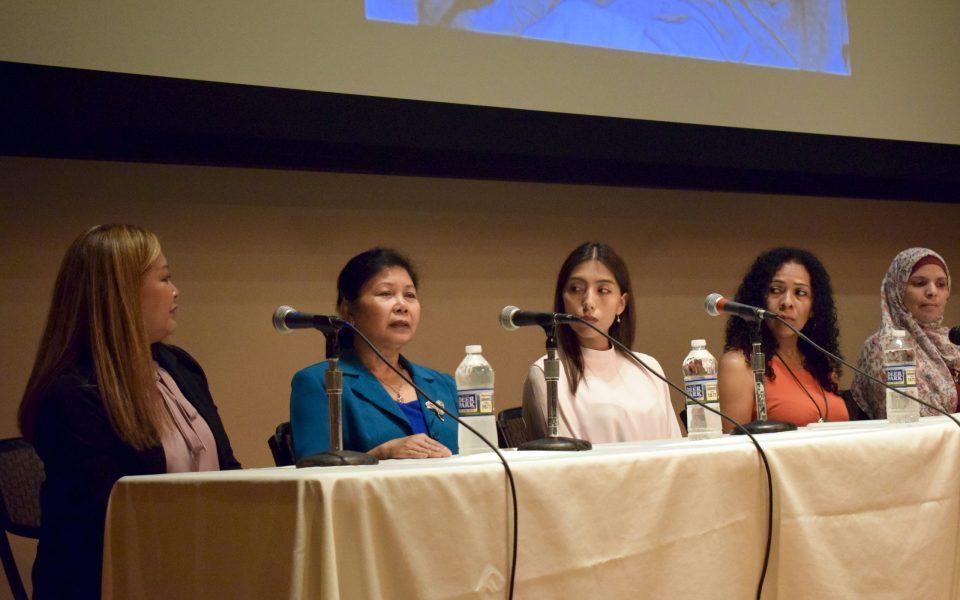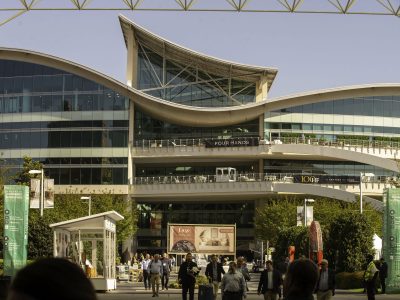The pea crop failed 2,500 destitute laborers in Nipomo, Cali. that winter, and Florence Owens Thompson had just sold her tent to buy food for her seven children when she allowed photographer Dorothea Lange to capture her image in what became one of the most emblematic photographs of 1930s America.
Lange’s original 1936 print of “Migrant Mother” is the principal feature in Reynolda House Museum of American Art’s latest exhibition on display through Dec. 30: Dorothea Lange’s America, a poignant collection of the social documentarian’s lifetime work accompanied by photographs from a few of Lange’s contemporaries like Walker Evans and Russell Lee. Tying the exhibition’s themes to local realities, the museum hosted a panel of four migrant mothers living in Winston-Salem who shared and reflected on their own migratory stories the evening of Sept. 27. Michael Wakeford, a historian and professor at UNC School of the Arts and the interim executive director of New Winston Museum, offered context while moderating the panel.
“Migrant motherhood is a generative part of this area’s story,” he said, “whether one is talking about the nomadic patterns of the Catawban people who long-proceeded Anglo-European settlements, the Moravians who journeyed into this area 250 years ago, African-American women who migrated with their families to the industrializing city in the late 19th Century or who exited North in flight from Jim Crow.”
No two stories are alike.
With the help of Vietnamese soldiers who navigated landmines Pha San, now 58, trekked the Cambodian border with Thailand through the night while pregnant with her first child to escape genocide under the Khmer Rouge regime in the late 1970s. After decades of manufacturing work in Lexington where she resettled, she now owns and operates Kernol’s Donuts in Winston-Salem which she opened in 2017.
Her niece Kim Anderson, also a Cambodian immigrant, assisted with translation during the panel.
“[My aunt] said when she first saw the photo, she initially saw hopelessness,” Anderson shared. “But after looking further she says she sensed courage, that there’s nothing at that moment that’s going to stop her from taking care of her family.”
Thompson — a white-passing Cherokee woman who remained anonymous until the 1970s — swiftly became an emblem of American motherhood but also of the conditions of abject poverty during the Great Depression. The close-up, black-and-white portrait harbors distressing irony: Thompson’s hand, strong from tireless labor, reveals her anxious dread as it meets her face which wears an expression of deep concern; there is a suggestion of futility here. Interestingly, “Migrant Mother” mimics the archetypical Madonna: the mother, the central symbol of the piece, cradles her baby; two of Thompson’s other children, though rebuffing the camera lens, are positioned somewhat like cherubs which often encircle the Madonna. Lange’s iconic photograph isn’t posed, though, and Thompson is vulnerable, heavy and apprehensive unlike the blissful religious figure.
It’s difficult not to draw a connection between these imageries and a transformative scene in Minerva Cisneros Garcia’s life roughly 20 years ago when she crossed the Rio Grande with her young children. As instructed, she pulled her boys in large black plastic bags (heads exposed). They depended on their mother completely, just as Thompson’s young children did in the midst of a frozen pea field.
“The children give her the power to get up and… do what she need to do for the sake of the kids,” Garcia said of the photograph. Garcia, an undocumented woman who made headlines when she took sanctuary in a Greensboro church to avoid deportation in June 2017, currently finds herself in a vexing situation: In November, a federal immigration court will determine whether she and her sons will remain in North Carolina or face deportation.
“I feel sometimes scared and anxious and hopeless like the mother in the photo, but also I have hope… and I am praying the immigration judge will let me stay,” she says. “I admire America because the country is really safe…. Where I am from in Guerrero is one of the most dangerous areas; in Guerrero, they kill you for free.”
Like Garcia, Susan Alzamel asserted agency despite restrictive and terrifying conditions when she fled her war-torn home in Syria with her husband and four sons seven years ago. Her story also reveals the ironic immobility that often accompanies migratory experiences: before resettling in Winston-Salem through World Relief, she and her family spent four years in a refugee camp in Jordan.
Raysa Suarez Williams, an artist, poet and mother of three, immigrated most recently; she left Cochabamba, Bolivia for Winston-Salem to start anew with her growing family last December.
“We decided to leave everything we knew for stability… to give our children the security they deserve,” she said. “My little girls are fighters [and]… we are making it day-by-day, little-by-little. You need money to be stable, even if you don’t want to think that way. It has been a hard transition… to be so far away from everything you know when you feel isolated.
“I will say that this whole experience has made me mature a lot as a mother in ways I wasn’t expecting this time in my life,” Williams continued. “Looking at this migrant mother photograph, it’s empowering to think women can do so much, endure so much for the sake of their kids. They’re moved by love for their children, love for themselves as well, to be able to fight adversities and wars and uncertainty for a greater good.”
“We are all blessed we are alive and we are here. We are troopers.”
Join the First Amendment Society, a membership that goes directly to funding TCB‘s newsroom.
We believe that reporting can save the world.
The TCB First Amendment Society recognizes the vital role of a free, unfettered press with a bundling of local experiences designed to build community, and unique engagements with our newsroom that will help you understand, and shape, local journalism’s critical role in uplifting the people in our cities.
All revenue goes directly into the newsroom as reporters’ salaries and freelance commissions.





Leave a Reply